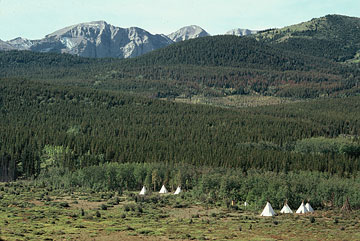A Calgary Stampede Stoney summertime long remembered
COFFEE WITH WARREN, with Warren Harbeck
Cochrane Eagle, July 11, 2007

A summer encampment in the foothills northwest of Morley reflects the beauty and happiness of the Stoney Way.
Photo by Warren Harbeck
This year is the 30th anniversary of an especially memorable Calgary Stampede for me.
Having for the first time passed the magical 1 million attendance mark just the previous year, the 1977 edition of “the greatest outdoor show on earth” had turned its spotlight onto the First Nations of Treaty Seven and their centennial celebrations of signing treaty with the Queen. As part of those celebrations, Prince Charles and the Treaty Seven chiefs were parade marshals.
My part was the production of “Stoney,” a multi-image slide show reflecting the heritage, happiness and hopes of one of the Treaty Seven nations, the Stoney Nakoda First Nation of Morley.
The Blackfoot (Siksika), Blood (Kainaiwa), Peigan (Piikani), Sarcee (Tsuu T’ina) and Stoney (Nakoda) – the five southern Alberta First Nations grouped together under Treaty Seven – have been part of the Calgary Stampede since its beginning in 1912. Their colourful regalia, the heartbeat of their drumming and dancing, their Indian Village tepee encampment, and the aroma and taste of their traditional fry bread lie at the very heart of this western Canadian summertime experience.
I had been a guest in the Stoney community since 1965 as a linguist, Scripture translation consultant and cross-cultural communicator. Photography had become an important tool in the interpretive process, and teaming up with Morley photographers Tom Snow and the late Gerald Kaquitts, we used our cameras to promote understanding and goodwill, both within the community and across community lines.
In the mid-1970s we had produced several slide shows that adopted as their musical backdrop Lobo’s hit love song of the day, “Stoney.” The refrain goes:
Stoney, happy all the time
Stoney, life is summertime
The joy you find in living every day
Stoney, how I love your simple ways.
Lobo’s love song became something of a “national anthem” in Stoney Country, and it inspired us to do photography and slide shows that portrayed beauty and happiness in the Stoney Way. These shows were not so much about looking at the Stoney community, as they were about looking at the joy of life through Stoney eyes.
Thus it was that we entered the Treaty Seven centennial celebration year. Word had got around about our productions, and the late Bill Pratt, then general manager of the Calgary Stampede and a strong promoter of understanding between First Nations and visitors to the Stampede, invited us to give a private showing of one of our shows to his Stampede theme committee.
They liked what they saw and not only welcomed us as one of the Treaty Seven theme exhibits, but gave us the exclusive use of the wonderful theatre in the then-Kinsmen Centre. We committed ourselves to running a world-class exhibition-quality three-screen six-projector upgrade of our Stoney show, to be repeated a dozen or so times daily throughout the 10-day event.
We enjoyed the enthusiastic support of the entire Stoney community.
There couldn’t have been a better year to showcase the Stoney Way. The production would honour the community’s achievements in accommodating “the best from both worlds” – from the Stoney traditional world, and from the non-Stoney world. Not only would it celebrate the elders’ respect for nature and community, but also the explosion of Stoney young people completing high school and earning university degrees; the restoration of self-government; the hosting of major inter-tribal gatherings, such as the Indian Ecumenical Conference; and the development of commercial enterprises – all made possible in no small measure by the community’s management of its recently-developed oil and gas resources.
The show was narrated by one of Morley’s first university graduates, the late Shirley Crawler, granddaughter of chief Walking Buffalo, a leader comfortable in the presence of royalty.
When the show opened, there, sitting in the audience, was Charles, Prince of Wales. In Alberta for the re-enactment of the signing of Treaty Seven at Blackfoot Crossing, he was witness now to life among a First Nation who, in such a short time, had journeyed from travois to jet plane, and from smoke signals to computer, without losing the sense of awe at the wonder of creation.
The Calgary Stampede awarded us the trophy for best theme portrayal. It was a proud moment for all of us. Throughout Stoney Country that year, life was indeed summertime.
© 2007 Warren Harbeck
JoinMe@coffeewithwarren.com